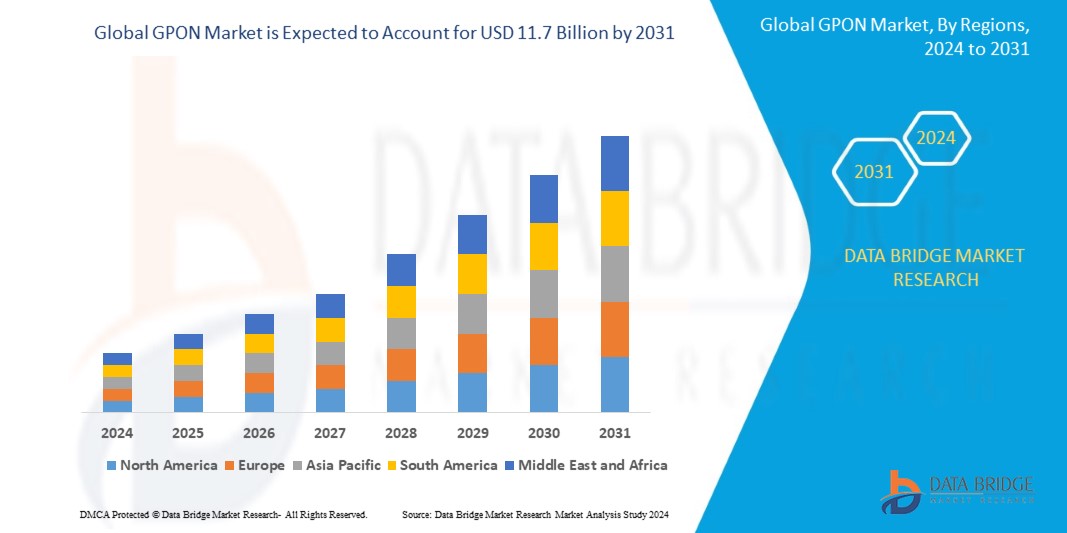In the era of hyper-connectivity, where digital services and cloud-based applications are becoming the backbone of modern economies, the demand for ultra-fast and reliable broadband access is rising at an unprecedented rate. Among the many technologies powering this digital transformation, GPON (Gigabit Passive Optical Network) stands out as a key enabler of next-generation communication infrastructures. It provides a cost-effective and scalable solution for delivering high-speed internet, voice, and video services to homes, businesses, and institutions. This article explores the dynamics of the GPON market, its growth drivers, applications, challenges, and the road ahead.
Understanding GPON Technology
GPON is a point-to-multipoint access network architecture that uses optical fiber and passive splitters to deliver gigabit-level data speeds from a central office to multiple end-users. Unlike traditional copper-based networks, GPON provides significantly higher bandwidth, lower latency, and greater energy efficiency. The system includes an Optical Line Terminal (OLT) at the service provider’s end and multiple Optical Network Units (ONUs) or Optical Network Terminals (ONTs) at the user’s end.
GPON supports downstream speeds of up to 2.5 Gbps and upstream speeds of up to 1.25 Gbps. This symmetrical performance is essential for modern applications like video conferencing, HD/4K streaming, cloud gaming, and enterprise-level data operations.
Key Market Drivers
1. Growing Demand for High-Speed Internet
The increasing penetration of digital services across the globe, especially in developing economies, is fueling the need for fast and reliable internet connectivity. Work-from-home models, online education, telemedicine, and streaming services are becoming mainstream, accelerating the adoption of fiber-based broadband solutions.
2. Government Initiatives for Digital Infrastructure
Governments across regions are launching initiatives to improve digital infrastructure in urban and rural areas. Programs focused on broadband expansion and smart city development are boosting the deployment of GPON networks.
3. Surge in FTTH Deployments
Fiber to the Home (FTTH) is a rapidly growing trend in the telecom sector, driven by the need for uninterrupted high-speed services. GPON forms the foundation of FTTH networks due to its scalability, bandwidth capacity, and cost-effectiveness.
4. Enterprise and Industrial Applications
Businesses and industrial facilities require robust connectivity solutions for their growing reliance on cloud computing, Internet of Things (IoT), and real-time data analytics. GPON’s low latency and high throughput make it ideal for these mission-critical operations.
5. Migration from Legacy Networks
Telecom operators are phasing out copper and coaxial cable networks in favor of fiber-optic systems to reduce maintenance costs and meet rising data demands. GPON offers a smooth transition path with minimal infrastructure changes.
Key Market Segments
The GPON market is broadly segmented based on component, technology, application, and region.
1. By Component
- Optical Line Terminal (OLT)
- Optical Network Terminal (ONT)/Optical Network Unit (ONU)
ONTs/ONUs are witnessing higher demand with the rapid expansion of FTTH networks, while OLTs are crucial for back-end support and scalability.
2. By Technology
- 2.5G GPON (standard)
- 10G GPON (XG-PON, XGS-PON)
- NG-PON2 (Next Generation)
Next-generation GPON technologies such as XGS-PON and NG-PON2 are gaining traction due to their enhanced capabilities, including higher speeds and support for multiple services over a single network.
3. By Application
- Residential
- Commercial/Enterprise
- Telecommunication
- Healthcare
- Education
- Government & Defense
While residential applications dominate in volume, commercial and government deployments offer higher revenue per connection, making them a lucrative market segment.
Regional Insights
North America
North America leads in GPON adoption due to early infrastructure development and the presence of key technology providers. The rollout of 5G and investments in smart cities are further fueling growth.
Asia-Pacific
Asia-Pacific is the fastest-growing region in the GPON market, driven by high population density, urbanization, and government-backed digital initiatives in countries like China, India, and South Korea.
Europe
Europe has a strong focus on sustainability and digital inclusion, leading to widespread GPON deployment in both urban and rural areas.
Middle East and Africa
Although still emerging, the MEA region is showing potential with increasing investment in fiber networks and smart city projects.
Competitive Landscape
The GPON market is highly competitive with both established telecom equipment vendors and emerging technology providers participating. Key players are focusing on product innovation, strategic partnerships, and geographic expansion to strengthen their market position. Vendors are also investing in software-defined networking (SDN) and virtualization technologies to enhance the efficiency and flexibility of GPON solutions.
Challenges in the GPON Market
1. High Initial Investment
Despite long-term cost savings, the initial capital expenditure for GPON infrastructure deployment is relatively high. This can be a barrier for small telecom operators and in regions with lower internet penetration.
2. Complex Network Management
Managing and maintaining large-scale GPON networks requires technical expertise, particularly when integrating advanced technologies like SDN, NFV, or cloud orchestration.
3. Security Concerns
As GPON networks are shared across multiple users, data security and privacy are crucial. Service providers must ensure encryption and secure authentication to prevent unauthorized access.
4. Technological Obsolescence
With rapid advancements in fiber-optic and wireless technologies, there’s a risk of certain GPON variants becoming obsolete. Providers must balance investments with future-readiness.
Future Outlook
The GPON market is poised for substantial growth over the next decade. Emerging technologies such as 10G GPON, software-defined access networks, and hybrid fiber-wireless systems are expected to redefine the landscape. In addition, the convergence of fixed-line and mobile networks (FMC) and the integration of GPON with 5G backhaul will unlock new possibilities for service providers.
Smart homes, autonomous vehicles, and industrial automation will depend on high-capacity, low-latency connections, further expanding the application spectrum of GPON. Moreover, the integration of AI-driven analytics in GPON networks will enable proactive maintenance, dynamic bandwidth allocation, and better quality of service (QoS) management.
Conclusion
GPON has emerged as a transformative technology that meets the growing demands of the digital world. By offering high-speed, reliable, and cost-effective connectivity, it serves as the foundation for next-generation broadband infrastructure. While there are challenges in terms of investment and management, the long-term benefits of scalability, energy efficiency, and user experience make GPON a compelling choice for telecom operators and governments alike.
Read more Details : https://www.databridgemarketresearch.com/reports/global-gpon-market
